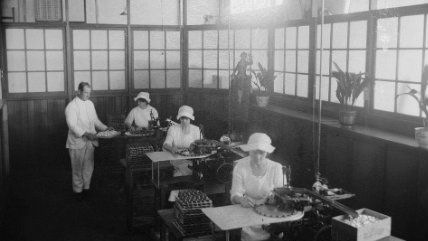Progressives—Screwing Up Feminist Gains in America Since the Early 1900s
How early 20th-century social reformers teamed up with the state to limit women's workforce advancement.

Did you know that many early U.S. labor reformers were motivated more by fear of working women than love for the proletariat? Or that, once upon a time, the slogan "equal pay for equal work"—now a rallying cry for all sorts of new regulations—was once used by feminists to protest government meddling in the marketplace? These are just two of many fascinating tidbits from Jeffrey Tucker's exploration into the "government's war on women: 1900-1920."
According to pop-history, women didn't really start entering the workforce en masse until World War II—a workforce from which they were promptly booted when the boys returned from overseas. It wasn't until Betty Friedan and company started kicking up shit in the early '60s that second-wave feminism—with its emphasis on women's economic as well as sexual opportunity—really started to take back the punch clock.
But there's trouble with this narrative, writes Tucker. With the industrial revolution came all sorts of new opportunities for women, and by 1910, women accounted for around one-fifth of the entire U.S. workforce. Their wages, while still lower than men's, were rising quickly: up 16 percent between 1890 and 1920. And female pay relative to men's pay was also higher in 1920 than it was in 1980.
Yet the early decades of the 20th century "were also the years in which we first saw government intervention in the labor market, much of it specifically targeting women," writes Tucker.
Society must control reproduction and therefore what women do with their lives. So said the prevailing ideology of the age. We couldn't have a situation in which markets enticed women to leave the control of their families and move to the city.
Though they are called Progressives, the reformers' rhetoric had more in common with the "family values" movement of the 1970s and '80s — with pseudoscientific race paranoia playing the role that religion would later play. In many ways, they were the ultimate conservatives, attempting to roll back the tide of history made possible by the advance of the capitalist economy.
They were incredibly successful. Over a 10-year period between 1909 and 1919, 40 states restricted the number of hours that women employees could work. Fifteen states passed new minimum wage laws to limit entry-level jobs. Most states created stipends for single-parent families, specifically to incentivize women to reject commercial life, return to protected domesticity, and stop competing with men for wages.
Such laws were completely new in American history (and in almost all of modern history) because they intervened so fundamentally in the right of workers and employers to make any sort of contract….How did all this happen so fast, and why?
See Tucker's whole piece for an attempt at answering that tricky question. One last thing I want to highlight is how feminist activists once protested against government micromanagement of their working lives.
Between 1900 and 1920, notes Tucker, "hundreds of laws stifling [working] women were passed in every state and at the federal level," including limits on what times of day they could work, how many hours they could work, and in what roles. And these laws drew the ire of early feminists across the country. In New York, the Equal Opportunity League lobbied hard for the state to repeal gendered labor laws, stating that "a law that is unconstitutional for a man voter is equally unconstitutional for a woman voter."
"Working at night is not more injurious than working in the daytime," the league argued. "Many women prefer to work at night because the wage is higher, opportunities for advancement greater, and women with children can enjoy being with their child after school hours in the day time."
In fact, the phrase "equal pay for equal work" was not created to mandate higher wages for women. It was a league slogan invoked to argue against laws that made it "a crime to employ women even five minutes after the eight-hour day." The phrase emerged as a preferred slogan to protest in favor of free markets, not against them.
Unfortunately, today's progressives are up to the same old shenanigans. You see it when they say it's okay for the state to demand hundreds of dollars and a year's time for the right to paint nails, but it's criminally exploitative for small-business owners to pay unskilled manicurists only in tips while they're being trained. You see it when progressives say that the "on-demand economy," comprised of Uber et al., is exploitative because while it provides people with flexible work, it doesn't offer health-insurance coverage. You see it when they say that prostitution should be illegal for the good of the women in the sex industry, or when they ask the federal government to make all employers offer paid maternity leave.
Sure, today's progressives are motivated by different cultural cues. But the impulse ("I know what's best for any and all people's lives") and the results (regulations that depress wages and harm women's work prospects) are the same.
There will always be these types of people. But perhaps we'd have an easier time convincing each new generation of their danger if we weren't operating under a fairy tale version of history. This story "says that during the 20th century, government freed women to become newly empowered in the workplace," but "the reality is exactly the opposite," writes Tucker. "Just as the market was granting women more choices, government swept in to limit them in the name of health, purity, family values, and social uplift."
For more on "the sexist collectivism" of the early progressive movement, see this 2008 essay from Reason senior editor Damon Root.